Wagon Reviews
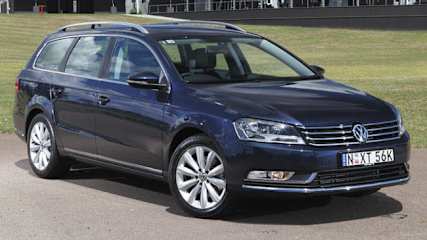
Volkswagen Passat 118TSI wagon 2011 review
Read the article
By Peter Barnwell · 16 Nov 2011
They've sold 15 million of them and the new one is better than ever - safer, more fuel efficient, better looking, affordable. We got hold of the base model 1.8-litre TSi Passat wagon.It's a turbo petrol powered model and frankly, due to impressive fuel economy (7.5-litres/100km, low 6s on a trip) and strong roll on acceleration, we initially thought it might have been one of VW's new, smooth running, quiet turbodiesels.It throws a cat among the pigeons for us turbodiesel die-hards who relish the oil burner's punchy low end torque and infrequent visits to the servo'.This is the seventh generation Passat and features VW family styling being ushered in progressively across the entire range. Main emphasis is on the front end and hopefully, VW will not go too far down a generic styling path with its current cars.The 118TSi we drove is, realistically, all you would ever need in a passenger car especially with the seven-speed, double-clutch, DSG transmission that fully captures all available power and torque from the turbo engine and efficiently puts it to the road through the front wheels.This model has a 1.8-litre engine, which, as the name suggests, is good for 118kW and a handy 250Nm from as low as 1500rpm. It passes Euro 5 emissions regs' on 95 octane fuel.Despite being the entry level model, this car is impressively equipped for the $40,990 pricetag with goodies like leather upholstery, large touch screen multi function display, Bluetooth and audio streaming, driver fatigue detection, park distance control, decent audio, climate control and 17-inch alloys.It has a five star crash rating thanks in part to no less than eight air bags. The interior is stylish and functional highlighted by discrete touches of chrome and brushed metal.The exterior appearance is set off by chrome roof rails and chrome body hardware. It carries five adults easily and has a large, expandable load space. Nothing to complain about here, it's all good.
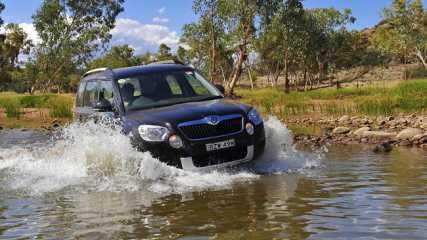
Skoda Yeti AWD 2011 review
Read the article
By Neil Dowling · 04 Nov 2011
Dreams of touring the Outback with your family may be just that - dreams. But at least there is a growing batch of affordable SUVs that could make the wish come true.
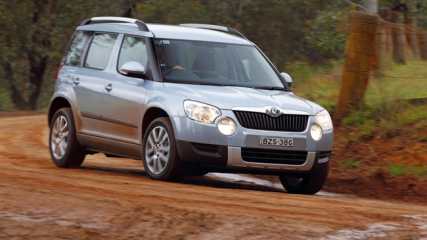
Skoda Yeti 103TDi 2011 review
Read the article
By Peter Barnwell · 30 Oct 2011
Skoda is slowly edging its way into the Aussie psyche with some interesting, well priced models. All use Volkswagen underpinnings including the new Yeti compact SUV.Leveraged from the Skoda Octavia Scout platform with some VW Tiguan thrown in, boldly styled Yeti has the credentials to lift the brand to a new level in Australia. It ain't pretty but is practical and despite being a soft roader in 4x4 guise, will go almost anywhere thanks to its clever drive system. Equally, the front wheel drive models will win over plenty of punters if only because of the price. Yeti has taken too long to arrive here but the wait could have been worth it.THE LINE-UPFour models are initially offered, the turbo petrol front wheel drive only 77TSI six-speed manual for $26,290, add $2300 for the seven speed DSG model and then there's the all wheel drive turbodiesel 103TDI six-speed manual at $35,690, add $2300 for the six-speed DSG.A 118TSi petrol model is a likely starter next year possibly in all wheel drive.The engines are transversely mounted to optimise interior space and provide better crash protection.The 103TDI has an four-wheel-drive system incorporating a fourth-generation Haldex clutch. Peak power (103kW) is reached at 4,200 rpm with the TDI engine producing up to 320Nm of torque between 1,750 and 2,500 rpm. Fuel consumption for the 103TDI averages 6.2 l/100kms for the manual, a little more for the DSG.The tiny 1.2-litre turbo petrol engine features direct injection and delivers 77kW/175Nm output, the latter from 1550rpm. It is capable of returning a creditable 6.6 litre/100 kilometres for the manual.FEATURESAll Yetis have Skoda's innovative VarioFlex rear seating system in addition to air conditioning, power steering, seven airbags including dual front, front side, curtain and driver's knee airbags and central door locking.Standard kit in 77TSi includes 16-inch alloys and a 16-inch steel spare, black roof rails, cruise, six air bags, power windows and exterior (heated) mirrors, height adjustable halogen projector headlights, height and reach-adjustable four-spoke multi-function leather steering wheel (with radio and phone controls), aircon, eight speaker audio, remote central locking and other practical goodies.The significantly more expensive 4WD 103TDi gets more again.SAFETYYeti's crash rating should be five stars as it shares underpinnings with five star cars in the VW stable. Six air bags, stability control, crumple zones, a high strength body and discs all round are in its safety arsenal.THE DRIVESurprisingly firm but comfortable in the rough. Skoda seems to have arrived at an ideal suspension calibration for Yeti in both spec'. The petrol 77TSi can struggle when loaded but goes surprisingly well considering its lack of cubes under the bonnet. Fuel economy is a strong point as is the seven-speed DSG which does a lot to cover for the diminutive engine.The diesel 103TDi is the one to get albeit at nearly 10 grand more. It has oodles of grunt and is quite a spirited performancer on the highway, and plonks away nicely off road where it is surprisingly competent. Fuel economy is exceptional and the vehicle is a good size inside and out.Generous equipment levels are appreciated.VERDICTYeti doesn't make chosing a compact SUV any easier. It ticks most of the boxes and the chunky styling has special appeal all of its own. Gets a bit pricey when you opt for diesel auto and add a few options. Definitley worth a look.
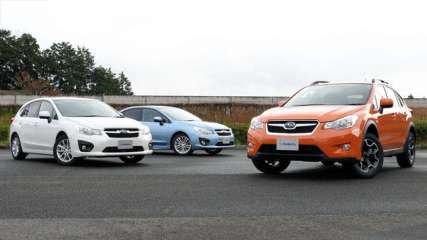
Subaru Impreza and XV 2011 Review
Read the article
By Mark Hinchliffe · 26 Oct 2011
You can be forgiven for confusion about the Subaru Impreza XV.The Impreza RX used to be a wagonesque variant of the Impreza that sold only about 100 a month until supply ran out in June because of production issues caused by the March 11 tsunami in Japan. But the new Subaru XV -- Subaru's seventh model -- has dropped the Impreza tag and has morphed into a small SUV. It is still based on the new-generation Impreza, but as Subaru Australia marketing boss Andrew Caie says, the two cars are "like chalk and cheese"."They are two separate categories, two totally separate cars and separate customers," he says. While the Impreza RX was considered a small car, this new model is described as a sub-compact SUV, smaller than a Forester, but bigger than a small hatch. The RX will arrive in Australia in January and will be followed in late February by the new Impreza four-door sedan and five-door hatch."The timing is everything to do with the tsunami," Caie says. "Our timings have been moved around about four times." The Impreza and XV will be the first Subarus with stop-start technology that switches off the engine when the vehicle is stationary. They also feature new transmissions and a new engine.VALUECaie isn't talking pricing at the moment, except to say that both the Impreza and XV will be competitive. "Prices will be as low as they possibly can be," he says. "We're trying to put as much value into them as possible. It's not about being the first one to the bottom in pricing."The current Impreza range starts at $21,490 and goes to $28,490, excluding WRX and WRX STI which are now separate sportier models with their own build program. The previous Impreza RX sold for $25,990. The closest competitors for the XV are the Mitsubishi ASX (from $25,990) and Nissan Dualis (from $24,990). Both new Subaru models come in three models: 2.0i, L and S.Even the base models come with Bluetooth while the L adds satnav and the S adds leather seats, heated in the front. Rear view camera, fog lights and a sunroof are optional on the L and S Impreza but are standard on all XVs.SAFETYSubaru Australia boss Nick Senior reminds us that they were the first company in Australia to have five-star safety across its range. "You can't be reactive in safety. You have to be proactive and we traditionally have been," he says. The new Impreza and XV come with seven airbags, including full-length curtain airbags and a knee bag for the driver.Neither has been crash tested yet, but Subaru product GM Akihide Takeuchi expects that they will retain their five-star ratings. Other improvements in safety concentrate on improving visibility: The front seats have been raised, the A pillar has been narrowed and the door mirrors are 20 per cent larger. The body and chassis are 20kg lighter but are also 10 per cent stiffer and therefore safer, Takeuchi says.TECHNOLOGYThe Impreza will be the first small car in Australia to have auto stop-start across the range (except for the two hybrid models) while the XV will be the first compact SUV with the fuel-saving technology. Subaru quotes fuel savings of 5 per cent from the technology, but those are in-house figures and not Australian standards. "It will debunk the theory that all-wheel-drive cars aren't fuel efficient," says Takeuchi.Stop-start technology automatically switches off the engine in 0.5 seconds when the car is stopped and restarts in 0.35 seconds when the brake pedal is released. Together with the new two-litre boxer engine, new transmissions, improved aerodynamics and electric power steering, fuel economy has been increased 20 per cent to less than seven litres per 100km, Takeuchi says.The engine has the same power and torque as before but now has longer pistons for more torque at lower revs which translates to increased acceleration. The five-speed manual has been upgraded to six speeds with a taller top gear that reduces engine revs from 3000rpm at 100km/h to less than 2500rpm, which is not only more economical, but also quieter. Subaru customers will be pleased to see the inadequate and outdated four-speed auto replaced by a continuously variable transmission with paddle shifters for six steps with wider ratios.Inside, the Impreza and XV abound with screens: one in the centre of the instruments, one in the centre stack and a third on the dashboard. The larger multi-function display has up to eight displays which can be personalised to show a range of useful and fun information and can even send you a happy birthday message.The upgraded audio also has USB, MP3 and iPhone connectivity and there is a new satnav system with voice control and predictive text when entering an address. It will even offer you a more economical route to save on fuel and CO2 emissions. Like all Subarus, they both come with symmetrical all-wheel drive.DESIGNTakeuchi says the cars have been designed from customer feedback wanting a sleeker exterior and more luxurious interior with more soft-touch surfaces and quality controls. The windscreen is raked, the bodywork more sculptured and muscular, and the headlights are sharper and more defined. The XV has high ground clearance of 220mm (same as the Forester), but has a lower body height than most compact SUVs for a rakish, sporty crossover look.Impreza is now 25mm longer in the wheelbase but the overall length remains the same which means interior legroom is improved. The higher front seats in the Impreza also allow rear passengers more legroom while both models have scalloped out the backs of the front seats for better knee room.Subaru has lowered the roof of the Impreza by 10mm, but the door sills have been dropped 30mm to allow easier access. The front door hinges have been slanted three degrees forward so the top of the door is further away from the car which allows more room to get in and out in tight carpark situations. The rear doorway also has a deeper access area.The interior feels more airy with the thinner A pillars and the horizontal lines across the dashboard. Door thickness has also been reduced for more shoulder and elbow room. Storage bins abound in both models with door pockets that fit a water bottle and an A4 folder or laptop.The centre console has a clever clip holder for a notebook and a pen so they don't rattle around. The cargo area is flat with a low loading lip and flat-folding rear seats. Underneath is a space-saver tyre, wide enough in the XV to still permit towing for a short distance. There are 10 exterior colours for both models, but the XV gets the special Tangerine Orange Pearl. Subaru is one of the few companies that doesn't charge extra for metallic or pearlescent paint.DRIVINGThe new cars were launched last weekend at the Fuji Heavy Industries Subaru research and development centre and proving ground at Kuzu in central Japan. It's a hilly area surrounded by forests inhabited by black bears, so Subaru is not concerned about spies taking photos of their cars in testing.We were only allowed two laps in each car on the high-speed bowl and three laps of a shorter twisty and bumpy circuit. About 12km in all. Not a thorough workout by any means, but enough to draw initial impressions.The soft interior plastic surfaces and firmer controls, such as the new door handles, give the cars a feeling of quality. However, the thinner dors feel a little flimsy when closing. Cargo space in the XV is disappointing, but similar to its sub-compact SUV competitors.On the road, they run quiet and smooth thanks to the new transmissions, but the wind noise from the larger door mirrors is increased. The frisky Impreza feels light and more flickable while the XV lumbers into corners, changes direction too slowly and over mid-corner bumps it hit the bumps stops several times and the tyre scrubbed the inside of the wheel arches.Takeuchi says the secret to the Impreza's deft handling is its low centre of gravity which is 504mm from the ground, comparing favourably with the Porsche Cayman S at 485mm. The CVT is smooth, responsive and seamless, but works best when used in manual mode with the paddle shifters, while the six-speed manual is a little notchy and it can be difficult to quickly engage third or fifth gears.VERDICTImpreza is another small step forward in quality, economy and safety that will appeal to the Subaru loyalists. Price may determine whether it wins new fans. Meanwhile Subaru taps into one of the fastest-growing sectors of the showroom with the handsome new XV. It is a modern design with sound technologies. Takeuchi says it is an urban adventurer whose owners are "living in the suburbs and are looking for new adventures".SUBARU IMPREZA and XVOn sale: January (RX), February (Impreza)Prices: from about $22,000Warranty: 3yrs/iunlimited kmService: 12,500km, biannualEngine: 2.0L, 4-cylinder boxer, 110kW/196NmTransmissions: 6-speed manual, CVTEcomomy: 6.9L/100km to 7.3L/100kmSafety: 7 airbags, stability control, ABS.
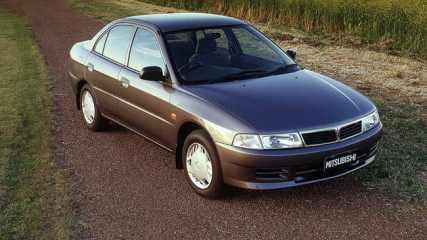
Used Mitsubishi Lancer review: 1996-2004
Read the article
By Graham Smith · 21 Oct 2011
Quality, condition and service history are the most important things to consider when choosing a cheaper car for the young motorist.Buy the best car you can afford, in the best condition, with a solid service history and you shouldn't go wrong.Most young drivers, or their parents, usually have a limited amount of money to spend, which necessitates looking at older models to find the ones that fit. Buying a quality older car almost certainly means buying one from a Japanese carmaker, such as the CE Mitsubishi Lancer.Mitsubishi launched the CE Lancer in 1996 and it ran until 2004. Prices now range around $1500 for the earliest examples to as much as $7000 for the last ones. It's available in practical sedan and wagon body styles, and a coupe, which is likely to be the most appealing to young drivers.Two four-cylinder single overhead camshaft engines were offered. One was a 1.5-litre, the other a larger 1.8-litre unit, both of which offered a combination of solid performance and good fuel economy. The GLi was the entry model and came in sedan and coupe form.It came standard with power steering, cloth trim, full wheel trims, and a fairly basic two-speaker sound system. For more there was the GLXi sedan and wagon that came with central locking, power mirrors and four-speaker sound.IN THE SHOPThe Lancer has an enviable reputation for reliability, but it depends heavily on being well serviced. Walk away from any car that hasn't been properly maintained, even if it appears a cheap buy. Mechanics who regularly work on them say the Lancer gives little trouble, although they stress that it's important to change the cam-timing belt as per Mitsubishi's recommendation of 90,000 km.Older cars tend to get knocked about by owners who couldn't care less, so look closely for panel damage that has been poorly repaired. Under the bonnet look for oil leaks around the engine and gearbox.IN A CRASHGenerally, the Lancer is a strong little car that stands up well in crash testing, making it a safe choice for young drivers. Importantly, Mitsubishi added dual front airbags in 2001, which makes that a key consideration when shopping. ANCAP rated the dual airbag model at 3 stars.UNDER THE PUMPMitsubishi claimed the Lancer averaged around 6.5 L/100 km in their lab tests, which makes it an economical little car. It took 91-octane unleaded fuel and Mitsubishi gave E10 ethanol blend fuel a tick.AT A GLANCEPrice new: $20,730 to $26,950Engine: 1.5-litre 4-cylinder; 69 kW/126 Nm 1.8-litre 4-cylinder; 86 kW/161 NmTransmission: 5-speed manual, 4-speed auto, front-wheel driveEconomy: 6.5 L/100 km Body: 4-door sedan, 4-door wagon, 2-door coupeVariants: GLi, GLXi Safety: 3-star ANCAP
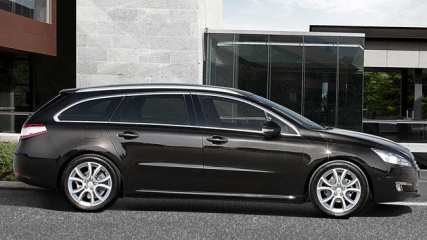
Peugeot 508 Allure Touring 2011 review
Read the article
By Stuart Innes · 20 Oct 2011
Peugeot's new medium-large wagon is a pretty good place to be, once you've come to realise a European does not have to be a pin-sharp sportster.The French automaker has got it spot-on by naming the wagon "Touring" and it should well satisfy owners and drivers who want some Euro prestige with lots of tech and toys, a stylish lifestyle vehicle, comfort and safety for (whisper it) less than 50 grand.So far in Australia, there's only one version of the 508 wagon - having a turbo-diesel engine and equipped to Allure trim level. A 1.6-litre turbo petrol engine (115kW/240Nm) is on the way.VALUEAt $45,990 the 4.8m Peugeot 508 Touring has few direct rivals, the obvious being the VW Passat Highline diesel. The Passat's lesser-known cousin, the Skoda Superb, is $2000 less and the fellow French Citroen C5 Tourer is $49,990.Which means the Peugeot is priced well under the luxury Swedish and German marques for this type of vehicle. If you're prepared to do away with the Euro image and some of the gadgets, diesel motoring can be found in a Mazda6 wagon for $36,250.This Peugeot 508 Touring stands up in the value equation: keyless entry and start, front and rear park assist, electric park brake and hill assist, eight-speaker sound, Bluetooth and USB, quad-zone climate control, power front seats and leather trim. A capped service program at $990 for the first three years/60,000km is offered.DESIGNPerhaps the most stylish Peugeot wagon ever seen. It's fresh, sleek, elegant yet has more space than the predecessor 407 wagon. The wagon space is large (612 litres with rear seat up).There's a ski port, the rear seat folds flat 60, 40 or all with the flick of levers by the tailgate, it has chromed tie-down hooks plus two upper hooks, elastic side straps and a cargo blind. There's a wide rear bumper to reach over but the load height is reasonable.Points lost for tiny glovebox and centre console bin sizes. A feature is the full length panoramic glass roof, which can be covered to various stages by a horizontal electric blind. Rear side windows have roll-up sunscreens/privacy blinds.TECHNOLOGYThe engine is what you'd expect from a Euro, which means quite OK. The 120kW of power and 340Nm of torque is par for a two-litre turbo-diesel. It feeds to a six-speed automatic transmission that has a sequential manual control with paddles behind the steering wheel and a Sport setting. Official diesel consumption is 5.7 litres/100km. We saw as low as 6.2 thanks to a country drive but ended with 6.6 in mostly gentle throttle use: it's warming to see 538km covered and still 520km to go on the tripcomputer (tank is 72 litres).Peugeot boasts of good aerodynamics and the 1544kg weight is commendably low for this size diesel wagon, aided by an aluminium bonnet. The tailgate has assisted opening and electric closing. SAFETY Six airbags, all the acronyms for braking, collapsible steering column and brake pedal, three rear child seat restraint anchorage points, flexible cargo net and five-star ANCAP crash test score should assure buyers.DRIVEKeyless entry and start is not just a party trick but very practical. The power seat has plenty of adjustment although, as is the way with many modern cars, the driver must peer around the A-pillar at intersections. Rear seat passengers get comfort and separate vent controls (and love the full glass roof).The flat-bottom steering wheel is leather-clad but the driver lacks direct feel with the road. Yes, it safely gets around corners but this wagon is no sports car. Notably, the GT sedan version gets a different front suspension. Slip the auto shifter across to the S setting and the car becomes more willing (0-100km/h in 9.5sec) and even in normal D mode the paddle shift can be used to invoke engine braking down a hill.Engine noise is well suppressed. Passengers might never know it's a diesel - unless a window is down at cold start-up. But tyre roar and road noise are there, although we drove a Touring with lower, 45-profile tyres on optional 18in instead of 17in standard rims. It's not the only Euro car to let you know you're on a coarse Aussie road surface.VERDICTThe real plus in this stylish wagon is to enjoy the comfort, the fair value and space plus the prestige of a Euro car badge. Don't expect it to be a German-like sportster wagon in nimble handing and steering. But do cash in on the diesel engine's frugality and range. This Touring is a good tourer.

Volvo V60 T6 R-Design 2011 Review
Read the article
By Chris Riley · 18 Oct 2011
We ended up keeping this car longer and driving it further than anticipated which was a good thing for Volvo because we grew to really like it. If you're in the market for a premium sports wagon look no further because the T6 has all the bases covered.Attractively priced with some great deals at the moment it's got what it takes to give the Germans a run for their money.VALUEThe T6 with the R Design goodies is the top of the line V60, complete with all-wheel drive and a turbocharged six cylinder engine. It looks fabulous, it's easy and comfortable to drive and offers the practicality of a wagon with plenty of performance to boot.Priced from $72,150 it is well equipped in standard form and is an attractive proposition for those shoping European ie. Benz, BMW or Audi.TECHNOLOGYAll cutting edge. All wheel drive is standard. The 3.0-litre T6 turbocharged petrol engine pumps out 224kW of power and 440Nm of torque. 0-100 km/h takes 6.2 seconds and the top speed is electronically limited to 250km/h. Fuel consumption is 10.3 litres/100km (we were getting 10.6).Power is delivered to all-four wheels through a second-generation Geartronic six-speed automatic, as opposed to the double clutch transmission in the T5. New valves and lower friction mean faster gearchanges than before.DESIGNVolvo has managed to find a look all of its own. The V60 is a newcomer to the popular mid-size segment. While it retains the key elements that make it a Volvo (cross-braced grille and largish ail lights) function seems to have accommodated form this time around because it has lost that awkwardness exhibited by previous models. The overall effect is a sleeker, faster looking, more desirable motor car.SAFETYGets a full five stars for safety. The T6 is also all-wheel drive for sure-footted handling. And our test vehicle was also optioned with the Driver Support Pack which adds Adaptive cruise, lane departure waring and blind spot awareness. We're sold on adaptive cruise and blind spot awareness - but lane departure is more of an annoyance than anything else - together though they're $4990.DRIVINGWe clocked up more than 1200km in this car over the recent long weekend. It's a comfortable tourer, for both front and rear seat passengers. Adaptive cruiser is ideal for heavy traffic where it keeps a safe distance between you and the car in front, with no need to touch the brakes.The T6 is fitted with sports suspension and larger 18 inch wheels and rubber. The ride is not as harash as we remember and there's plenty of pickup for overtaking, but at 1800kg it's no sports car. Think easy, relaxed effortless performance and you're nearer the mark.VERDICTA great looking car for a great price. Volvo has really got its act together and the cars look and go a lot better. The tough question is chosing between the economical T5 or hard htting T6 - but one things for sure we'd take the R Design kit every time.VOLVO V60 T6 R DESIGNPrice: from $72,150Warranty: 3-years/unlimited km, roadside assistResale: n/aService interval: 15,000km/12 monthsSafety: 5-star Euro NCAPEngine: 6-cyl turbo-petrol, 224kW/440NmBody: 5-door wagonWeight: from 1804kgTransmission: 6-speed auto, AWDThirst: 10.3L/100km, 98 RON, CO2 247g/km (3-litre).
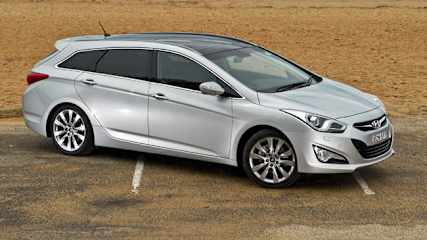
Hyundai i40 2011 Review
Read the article
By Peter Barnwell · 17 Oct 2011
As luck would have it, Hyundai Australia is able to source models designed for Europe and from Korea, meaning some doubling up in certain segments. Buyers stand to benefit with a rich selection, all with more improvements, features, safety and style.Latest cab of the rank is the i40 Tourer, a medium size wagon designed in Germany and built in Korea. It's slightly smaller scale than i45 sedan but more handsome and thanks to local development, better mannered and a better drive.The i40 Tourer is so good in this department as to rate the best ride/handling vehicle in the current local Hyundai lineup.Three variants are offered; Active, Elite and Premium with ascending levels of specification. There are two engine choices - a new direct injection 2.0-litre petrol four cylinder and a new 1.7-litre turbodiesel. They are matched to a choice of six-speed transmissions in manual and auto. But manual is only available on the entry Active model.VALUEActive petrol manual starts at $32,490 with diesel attracting a two grand premium and auto another two grand. Elite auto is $39,490 and Premium auto is $44,490 WHAT YOU GET All score alloy wheels, nine air bags, active safety systems and cornering lights. All have a five star crash rating.Cornering brake control is standard as are LED front driving lights, air conditioning, remote central locking, a full size spare, electric parking brake and multi media connectivity with Bluetooth phone and audio. Upscale models get more with, get this, air conditioning to the seats featured on the top variants. Premium gains leather, premium audio, 18-inch alloys, button start, front and rear park sensors, panoramic sunroof and reversing camera.All are well equipped.ENGINESBoth engines are new to Hyundai and will flow into other models in some form or other. The diesel is good for 100kW/320/330Nm (auto/manual) and as little as 4.7-litres/100km. The petrol is good for 130kW/213Nm and as little as 6.8-litres/100km. The engines rate 3.5-5.0 in the government's Green Car ratings.With 70 litres aboard, Hyundai reckons the diesel manual has a range of 1489km an astonishing distance for a car selling in the mid 30 grand price range. The six-speed auto is generic in Hyundai and Kia's lineup and offers paddle shift and sports mode right down to the entry model.DESIGNComing out of Hyundai's German design studio, the swoopy looking i40 Tourer is one of the better looking wagons on the market right now. It follows through with a family Hyundai look to the front complete with a hexagonal grille and eagle eye headlights. The interior is modern, stylish and functional leaving many Japanese contenders in its wake.DRIVINGWe got to drive the Active turbodiesel auto and the Premium petrol and frankly, prefer the base model Active diesel though both are impressive. Hyundai has totally nailed the ride/handling in i40 which offers sporty but controlled handling, responsive stering and feels well tied down.The diesel's luscious torque is a strong point over its petrol stablemate, plus the fact that it is super economical. It doesn't feel like a wagon when pushing hard on a winding, undulating road and scoots along smoothly and quietly on the highway.The interior is comfortable providing luxurious rear seat room and comfy seats. The diesel is noisier than the petrol but only under hard acceleration.VERDICTBest in Hyundai's lineup. Eclipses many Japanese (and European) competitors at less money. Striking looks. Unbeatable warranty.HYUNDAI i40 TOURERPrice: from $32,490 - $46,490Warranty: 5 years/unlimited kmResale: N/AService: 15,000km/12mthsThirst: 6.8-7.7L/100km, 91RON, CO2 159g/km; 4.7-6.0L/100km diesel CO2 124g/kmSafety equipment: 9 airbags, ESP, ABS, EBD, traction control, stability controlCrash rating: N/AEngines: 2.0-litre 4-cyl petrol 130kW/213Nm; 1.7-litre turbodiesel 100kW/325NmTransmissions: 6-speed manual, 6-speed auto with paddle-shifters, FWDBody: 4-door sedan, 5 seatsDimensions: Length 4770mm, width 1815mm, height 1470mmWheelbase: 2770mm, tracks front/rear 1591mm/1597mmWeight: 1420-1514kgTyres: 16x7.0; 17x7.5; 18x8Spare: Full-size alloy.
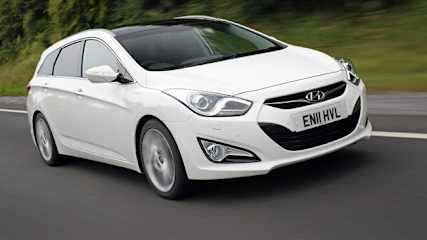
Hyundai 140 2011 Review
Read the article
By Karla Pincott · 14 Oct 2011
Korean brand Hyundai is steadily pushing away from its downmarket history, and the i40 Tourer - station wagon in Aussie - is the next step on that road.There's not a huge amount of choice if you're looking for an affordable mid-sized wagon, so the arrival of another contender was always going to be welcome. And with the i40, Hyundai is launching the range here with the wagon this month. It will be joined by a sedan by the end of the year in overseas markets, but i40 Tourer will serve here as the wagon complement to the brand's i45 in the mid-size field.VALUEThe i40 Tourer is available in three trim levels - Active, Elite and Premium. Prices start at $32,490 for the manual petrol drivetrain in Active trim with standard kit including daytime running lights and 'static bending' headlamps, electronic park brake, Bluetooth, cruise control, 16-in alloys wheels, full-size spare and premium steering wheel with audio and phone controls.Adding $2000 gets you the automatic transmission, and a further $2000 swaps the petrol engine for the diesel across the range.The auto-only Elite spec is $39,490 for the petrol, and includes premium audio, 17-in alloy wheels, larger disc brakes, alloy pedals, foglights, front and rear park assist, powered driver's seat and rain-sensing wipers.The same drivetrain in Premium spec is $44,490, and includes 18-in wheels, heated/cooled leather seats front and rear, adaptive cornering high-intensity headlights, reversing camera, panoramic glass roof and extra cosmetic garnish.With Toyota's Camry wagon having exited, the i40's main rivals are the Ford Mondeo, Mazda6 and Subaru Liberty wagons. But while it's priced and equipped to nip at their sales, it could be in trouble if people ever stop ignoring the great drivetrains and fit-out of the even better-priced Skoda Octavia.DESIGNThe signature for this car is bound to become the arabesque LED running lights. It's a startling feature but some people are going to find the curvilinear accent too fussy. The body is a sharply-penned translation of Hyundai's 'fluidic' design language, and every panel seems to be creased, folded and curved.The car sits low - which lends a sporty hint to the looks but means the front fascia is in danger of scraping over deep driveways - while a large roof spoiler and elongated light clusters add a sense of attitude.The stylish cabin relies mainly on the sculpted surfaces and lines of the dash flowing through onto the doors, picked up with metallised accents in the Premium spec. At this level you also get top-flight finishes and well-matched perforated leather for the heated/cooled seats front and rear. The centre console wouldn't look out of place in a German premium brand, but the steep angle means a lot of the digital information is unreadable in bright light.Hyundai has gone big on a vast array of blue-lit dials and instruments - 14 lights on the steering wheel alone - transforming the cockpit into an uber-tech display, but it risks attracting a queue of dazzled nightclubbers if you stray into the wrong postcode.TECHNOLOGYThe i40 Tourer range arrives with just two engines. The petrol unit is an all-new direct-injection 2.0-litre developing 130kW of power and 213Nm of torque.Official fuel figures for the petrol engine are posted as 6.8 l/100km when it's mated with the six-speed manual (in base model Active spec only) and 7.7 l/100km when it's joined to the six-speed auto.The turbodiesel engine is a 1.7-litre four-cylinder that develops 100kW of power and 320Nm of torque when mated to the auto transmission, giving a fuel figure of 5.6-6.0L/100km, while going for the manual gives you an extra 10Nm of torque while improving economy to 4.7L/100km.Like the i45 sedan it joins, the i40 Tourer's suspension set-up is MacPherson struts for the front and multi-link for the rear. However, after the poor reception to the i45's dynamics - which resulted in Hyundai recalibrating the sedan's suspension and steering - the Australian HQ's in-house engineers have reworked the wagon to bring it more in line with local driving styles and conditions.SAFETYIt has just a five-star ANCAP crash rating, with the local body awarding the stars based on the results of the i40's European NCAP test. The car has a standard list that includes nine airbags, stability and traction control, and anti-skid brakes with brakeforce distribution to counter uneven loading and brake assist to give extra 'boot' for panic stops.DRIVINGThe work done to 'Australianise' the steering and suspension shows, with a noticeable improvement on the revised i45. The steering is accurate and has much better-considered weight, although it's still on the light side. There's still nothing in the way of feel, but that's not out of order for buyers of a family wagon. They'll be similarly satisfied with the reasonably compliant ride and safe, dependable cornering, but it's not a car for the hard-driving enthusiast.We tested both engines with the six-speed auto, and found while the petrol unit is very quick from standstill, the torque doesn't keep tipping in as you climb. You can use the paddles for quick-think changes to pre-empt what the economy-focused transmission will do, but otherwise it's responsive enough without being spectacular.Our pick is the diesel, which isn't as zippy off the line, but delivers comfortably as you climb the rev range above 2000rpm, and never sounds agricultural on the job. It's the heavier unit, but you don't notice the difference.While the sharply angled front and rear windscreens enhance the looks, they undermine the visibility - compounded in the top spec by the larger rearview mirror, which includes a reversing camera to help you see out the back but leaves you a slot to peer underneath out the front.VERDICTWhile the i40 Tourer loses to some its rivals dynamically, it's a practical family package. It's well-priced against the competition, and better-styled than most of them. The fit-out is excellent at all levels, but the base model is especially good value - it leaves you wondering why you'd spend the extra to cram in any more features and garnish.HYUNDAI i40 TOURERPrice: from $32,490 - $46,490Warranty: 5 years/unlimited kmResale: N/AService: 15,000km/12mthsThirst: 6.8-7.7L/100km, 91RON, CO2 159g/km; 4.7-6.0L/100km diesel CO2 124g/kmSafety equipment: 9 airbags, ESP, ABS, EBD, traction control, stability controlCrash rating: N/AEngines: 2.0-litre 4-cyl petrol 130kW/213Nm; 1.7-litre turbodiesel 100kW/325NmTransmissions: 6-speed manual, 6-speed auto with paddle-shifters, FWDBody: 4-door sedan, 5 seatsDimensions: Length 4770mm, width 1815mm, height 1470mmWheelbase: 2770mm, tracks front/rear 1591mm/1597mmWeight: 1420-1514kgTyres: 16x7.0; 17x7.5; 18x8Spare: Full-size alloy

Used Lexus RX330 review: 2003-2006
Read the article
By Graham Smith · 14 Oct 2011
The Lexus RX330 was an SUV with the lot aimed not at those who want to blunder through the bush, but was instead aimed at those with a taste for luxury.It arrived in 2003 and was widely hailed as the best luxury SUV on the market. It was a high-riding, five-seat medium-sized wagon that was well equipped with heaps of luxury features, comfortable and quiet, as befits a luxury brand.The smooth 3.3-litre engine was a willing worker, doing its best stuff at higher revs, but if there was a criticism it was that it lacked a little grunt down low. Despite that the performance was good. Reflecting its position in the market there was just the one transmission option, a five-speed automatic with sequential shift. There was no manual transmission on offer, but the sequential shift function allowed the driver to change gears manually. Final drive was through all four wheels all the time, which came into its own on wet or loose surfaces.The Lexus didn't have a low-range crawler gear and its ground clearance was somewhat limited, so it was not an off-roader capable of climbing rocks or ploughing through sand.On the road the steering was light, the ride comfortable and the handling safe and sound without being sporting. Inside it had leather trim, climate controlled air, cruise, remote central locking, power front seats, power windows, and six-speaker CD sound.IN THE SHOPLexus came into the market on a promise of above average build quality and has generally lived up to that boast. While that has generally translated into enviable reliability and durability it's always a good idea to conduct a thorough check of any car you're thinking of buying. Ask for a service record to ensure the maintenance has been kept up as recommended. The cam timing belt change is due at 150,000 km, which means early examples are coming up to that service.Most, if not all RX330s, will have been confined to family duties around town, but it's a must that you get underneath and check for evidence of off-road use. If you think a car has been used off the beaten track continue shopping. The RX330 came packed with features, all of which should be operated to make sure they still work. Fixing them later on can be expensive.IN A CRASHThe RX330 is well equipped to handle a crash with seven airbags, ABS brakes and stability control. All up it was good enough to win a four- star tick from ANCAP.UNDER THE PUMPSize, weight and all-wheel drive all work against the RX330 when it comes to fuel consumption. The official claim was 12.3 L/100 km on average, which gives a bit of a hint to what you could expect in real life. Regular unleaded fuel made life a little easier, and E10 was approved to open up further savings.AT A GLANCEPrice new: $69,990 to $78,500Engine: 3.3-litre V6; 172 kW/328 NmTransmission: 5-speed automatic, 4WDEconomy: 12.3 L/100 km Body: 5-doos wagonVariants: Sports, Sports LuxurySafety: 4-star ANCAP




